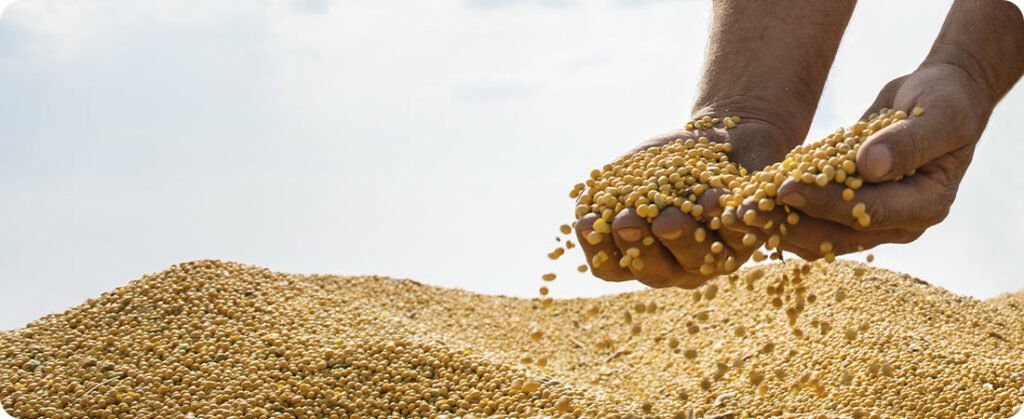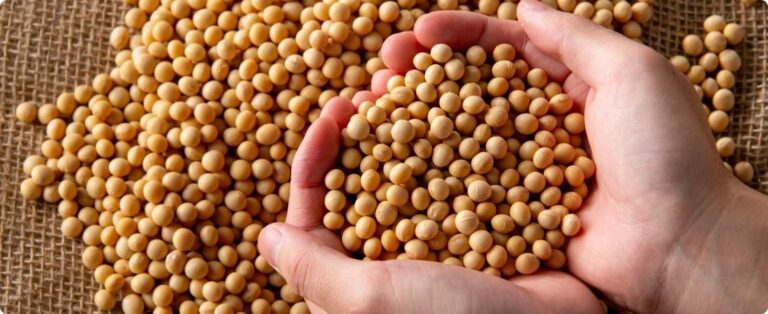
The harvest of Brazilian soybeans 2024/25 already exceeds 95% of area, according to the latest figures from Pátria Agronegócios, and now the market is clearly observing the size of the current national supply. This is undeniably a record harvest, however, it is concluding with numbers below those initially estimated. As in every season, weather problems were recorded in important production regions and, unfortunately, Rio Grande do Sul, once again, was a 'negative highlight'.
“Production results in Rio Grande do Sul continue to indicate a strong reduction in productivity,” says the Pátria team.
In a recent interview with Bom Dia Agronegócio, the president of Aprosoja Brasil, Maurício Buffon, stated that the 2024/25 harvest raised many doubts in terms of its real size, especially in January, which made it difficult to make a more assertive estimate earlier. “It is a good harvest, but we have had major problems in Brazil. It is a harvest that is smaller than planned, also supporting prices, because it began to be seen that it was not a harvest above 170 million tons as most consultancies estimated”, he says.
For Buffon, the Brazilian harvest is coming to fruition at less than 165 million tons due to the problems it has presented – having cited other states besides Rio Grande do Sul, such as Piauí, Mato Grosso do Sul, among others –, at the same time that the world market expected Brazil to have an offer of up to eight million tons greater.
Conab (National Supply Company) estimates the 2024/25 soybean harvest at 167.9 million tons.
Heated demand and impacts on stocks and premiums
While the Brazilian supply of soybeans, despite being a record, has shrunk due to adverse weather conditions, demand for soybeans has increased. This movement has been concentrating the strength of the largest global buyer since the trade war between China and the United States broke out. The market sentiment now is that the volume of soybeans available for sale will decrease. Furthermore, this reduction is expected to occur sooner than expected in the domestic market.
Brazilian soybean line-ups are more than 20% larger than last year, according to Matheus Pereira, director of Pátria Agronegócios. Brazil has set a record for soybeans committed for export. “Before all this fighting began (between China and the US), these conflicts already showed that, even with a record harvest in Brazil, we would also have record demand,” explains Pereira. According to him, this once again puts expectations for final soybean stocks at very low levels.
Pátria estimates that Brazil's final soybean stocks for the 2024/25 harvest should be 3.060 million tons, not much higher than the previous season's 1.640 million. In the 2023/24 season, however, Brazil harvested a much smaller crop, 147.74 million. For this harvest, the consultancy's number is 166.92 million tons.
Supply balance, stocks and futures market outlook
The managing partner of Pine Agronegócios, Alê Delara, shares this analysis.
“We have a record harvest, but we run the risk of a tight balance. China has already purchased much larger volumes than in previous years. If the trade impasse with the US persists, it will continue to buy from Brazil and Argentina. If we export around 106 to 107 million tons and the domestic market demands between 55 and 56 million, with a harvest of close to 170 million tons, final stocks would be between 4 and 4.5 million tons. This volume is considered tight,” he explains.
With stocks adjusted at the end of the season, the trend is for premiums in the Brazilian market to remain stable. There is also the possibility of new increases in the second half of the year. “Which would be natural due to the off-season,” adds Delara.
The premiums for the second half of the year and the beginning of 2026 are positive, according to Carlos Cogo, managing partner of Cogo Inteligência em Agronegócio. “This justifies the producer anticipating the purchase of inputs and carrying out barter operations now, taking advantage of the still positive premiums”, he advises.
Cogo warns, however, about the progress of negotiations between Donald Trump and Xi Jinping. “Despite China’s denials, a trade agreement between the US and China seems imminent. Since agreements of this type involve agricultural products, this has cooled the rise in premiums in Brazil. Some have already retreated and may fall further if the agreement is confirmed. Even so, the opportunity for good premiums in Brazil persists at the moment”, he concludes.
Domestic demand vs. exports
Both the directors of Pine and Pátria believe that there will be a more intense competition between exports and domestic demand in the coming months. This competition will occur due to the availability of soybeans. This will justify a leaner supply in the Brazilian market, and in advance.
“We have seen this dispute since January. The industry has very good margins and, therefore, has been paying more than exports. In recent months, the prices charged in the regions have been above export parity,” reports Alê Delara.
And Matheus Pereira adds that the warning for the Brazilian processing industry is great, given that this narrowing could happen sooner.
“The industry’s generalized strategy of aggressively entering the market in the second half of the year is shooting itself in the foot. Now, after the harvest, in seasonal moments when soybeans are in greater volume, with the need to sell the production base due, in particular, to financial needs, a large part of the industry is left with its arms crossed. I raise this issue because this same industry, which neglected the crop failures (2023/24) especially in Mato Grosso, paid R$ 40.00 more per bag of soybeans in three months because there was no product”, he explains.
Adjusted balance sheet and growth in exports of derivatives
This year, the scenario is no different and should not be, if the strategy remains the same. “We have an indisputably record harvest, it is the largest soybean harvest in Brazil’s history, but in the same proportion, we have a projection of record demand internally, plus an export that could add 11 or 12 million tons more soybeans in this current harvest cycle. And we are on track to beat this number. So, we still have a very tight balance”, says the Pátria analyst.
The consultancy estimates that Brazil's domestic consumption of soybeans will grow, from the previous harvest to this one, from 55.1 to 57.5 million tons and that national exports of the oilseed will reach an impressive 109 million tons.
Likewise, the Pine analyst also states that the Brazilian processing industry may not demand more soy to meet domestic consumption of bran and oil, but also for exports of derivatives that should grow in Brazil this year, considering, including, the suspension of activities of the largest processor in Argentina, Vicentin, announced this year.
On top of everything else, there is a shortage of soybeans in China
According to Eduardo Vanin, analyst of the soybean complex and director of Agrinvest Commodities, there is a shortage of soybeans in the Asian nation and the delivery of bran there is quite low. And the demand from the Chinese should remain concentrated in the Brazilian market.
“The soybean market was already experiencing a trade war even before tariffs (…) Brazil shipped a lot of soybeans, China had a record share, we shipped almost 38 million tons up until last Friday and China represents 77% of this shipment, based on line-ups, and last year it was 71%”, explains Vanin.
And the almost exclusive dependence on Brazil, especially by commercial processors, ends up worsening this scenario, also due to the delay in Brazilian shipments at the beginning of the year, something that could be repeated at the end of this year, including before the arrival of the new Brazilian harvest, if the tariff war between the US and China continues.
The concentration of soybean purchases from Brazil by China will inevitably result in more expensive soybean meal. This impact will likely be felt at some point by some end of the chain, especially by the end consumer. For Brazilian industry, the scenario may also be challenging. The industry will have to compete more intensely for soybean exports, which may result in higher prices, mainly through premiums.
Source: Carla Mendes | Notícias Agrícolas












